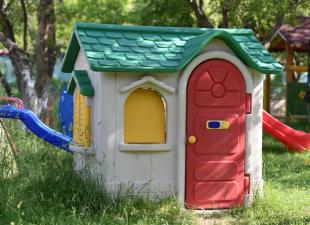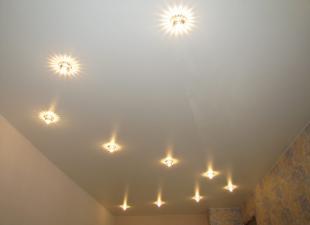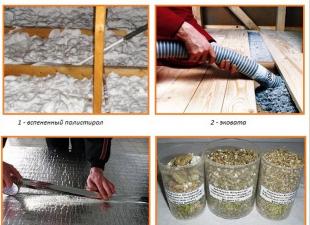Fluorescent daylight sources have replaced much less efficient counterparts, in particular, incandescent lamps. They are characterized by a considerable number of advantages that can outweigh the disadvantages. Given the relatively low cost, such lighting elements are widely used today.
Principle of operation and structure
Fluorescent lamps function according to the principle of the phenomenon of luminescence. For this, the inner walls of the flask must be covered with a phosphor. It is a special substance that absorbs ultraviolet light and produces a glow visible to the eye. It should be noted that UV radiation is produced as a result of the passage of an electric charge through the gaseous filling of the flask (inert gas, mercury vapor).
Main structural elements: a flask with electrodes inside; plinth in the amount of 1 or 2 pcs. depending on the version of the lamp; control gear. The last of the named elements can be inline or outlined.
A more new and perfect option is an electronic ballast, but fluorescent daylight sources of a linear type today are often equipped with remote electromagnetic ballasts.
Device and wiring diagram
The ballast includes a choke and a starter. The task of the first of the named nodes is to limit the current to the desired value, while the starter is responsible for faster heating of the electrodes, and hence the accelerated operation of the lamp.
Scheme for switching on a light source of newer models (T 5 or T8):
 The process of turning on the lighting element is ensured through the implementation of the main stages:
The process of turning on the lighting element is ensured through the implementation of the main stages:
- heating of electrodes;
- an ignition process that requires a high voltage pulse;
- voltage stabilization, due to which a normal and rather gentle mode of operation of the lighting element is ensured.
In addition, modern fluorescent lamps are protected from burnout, thus avoiding the need for frequent replacement of light sources.
What types are there?
There are several varieties that differ in the shape of the flask:
- linear (straight) execution;
- ring;
- U-shaped.
Fluorescent daylight sources are found in different variations, different in the length of the product. It can be a flask of 450, 600, 900, 1200, 1500 mm. It is noteworthy that the value of this parameter can be used to determine the power level of the lamp.
 This means that there is a direct relationship between these characteristics. The longer the length, the higher the value of the generated load. For example, a version with a length of 450 mm is characterized by a power of 15 W, and in a design of 900 mm, the load level is 30 W.
This means that there is a direct relationship between these characteristics. The longer the length, the higher the value of the generated load. For example, a version with a length of 450 mm is characterized by a power of 15 W, and in a design of 900 mm, the load level is 30 W.
Fluorescent daylight sources are presented in different versions, which differ in the diameter of the bulb:
The designation encodes the size of the product in inches (for example, diameter 4/8 for T4). Another feature is that linear lamps are usually equipped with a pin-type holder in a single version - G13. The designation of this base contains information about the distance between the pins (13 mm). Accordingly, when choosing luminaires, this nuance must be taken into account.
 The concept of "fluorescent light bulbs" is based on the main characteristic - the color temperature of the product. So, this kind of lighting elements is characterized by a light temperature in the range from 5,000 to 6,500 K. But the quality of illumination also ensures the level of brightness of the light source: the lower the radiation intensity, the more the colors will be distorted.
The concept of "fluorescent light bulbs" is based on the main characteristic - the color temperature of the product. So, this kind of lighting elements is characterized by a light temperature in the range from 5,000 to 6,500 K. But the quality of illumination also ensures the level of brightness of the light source: the lower the radiation intensity, the more the colors will be distorted.
Main technical characteristics
Evaluation of the efficiency of the lighting elements of this type is carried out on the basis of the compliance of their parameters with the conditions under which the operation is planned. Fluorescent lamps have the following characteristics:
- Product designation. Daylight is defined by the letter D.
- Flask diameter. This parameter affects the operating time: the higher its value, the longer the product will function.
- The power value, due to which the ability of the light bulb to illuminate the required area is determined. If we compare it with an incandescent lamp, then the analogue in question saves up to 80% of energy due to its low power level.
- Base type. In linear versions, the G13 holder is usually used.
- Power supply voltage. There are fluorescent lamps that are designed for 220 or 127 V.
- Flask shape.
- Colour temperature. Depending on the model, the lighting element can have temperatures ranging from 5,000 K and higher.
- Color rendering index - shows how good the lighting is.
- Tube diameter.
- Luminous flux of the product.

Classification and characteristics of various manufacturers
As you can see, there are quite a few characteristics, but all of them together make it possible to more accurately select the lighting element in accordance with the operating conditions.
Pros and cons of lamps of this type
Fluorescent light sources stand out from halogen and filament analogs due to the following advantages:
- high efficiency;
- excellent light output, which allows you to give out bright light at low power;
- lighting quality (diffused glow);
- low power consumption, again when compared with incandescent lamps;
- long-term operation (on average 6,000-9,000 hours), provided that ideal operating conditions are observed, such bulbs are capable of functioning several times longer (up to 20,000 hours).
Mercury-containing light sources have the main disadvantage - the presence of hazardous substances in the composition of the gaseous filling. The content of mercury in the bulb of a linear lighting element can be up to 1 g per unit of product. Given the rather large dimensions and thin glass from which the bulb is made, you need to handle such bulbs with extreme caution. Other cons:
- a narrow range of operating temperatures, since lighting elements of this type are characterized by a decrease in the glow intensity in cold conditions, and at subzero temperatures such a light bulb may not turn on at all;
- flickering, which is due to design features, partly this problem is solved by an electronic ballast;
- after a certain period of time, fluorescent lamps shine worse, which is due to the development of a phosphor layer, and as a result, the color temperature changes.
As you can see, there are many problems associated with the operation of such lighting elements. However, they continue to be used due to their relative economy and higher efficiency than incandescent bulbs.
Criterias of choice
Before buying, you should take into account the features of the room (area, the possibility of installing a large-sized light source), on the basis of which the lighting element of the required model is selected.
First of all, one should take into account the power of the product, color temperature, and the value of the supply voltage. The rest of the characteristics are secondary, but no less important: diameter, length and shape of the tube, color rendering index, luminous flux.
The build quality must be high given the presence of hazardous substances in the gaseous filling. Today you can buy linear light sources at a low price even from well-known and reliable manufacturers - Osram costing 60-100 rubles. Moreover, the price category of products of high power and the largest dimensions (1,500 mm) is indicated.
The nuances of operation and disposal
There are many features in the operation of linear lamps: not instantaneous operation; sometimes it is required to turn on again due to the fact that the ignition has not occurred; flickering; difficult operation at low temperatures, and sometimes a complete lack of reaction during switching.
In addition, there are other problems, namely the need to dispose of the light source if the bulb is damaged or after the end of its service life.
 parlini.ru Repair of an apartment, a summer residence and a house.
parlini.ru Repair of an apartment, a summer residence and a house.


